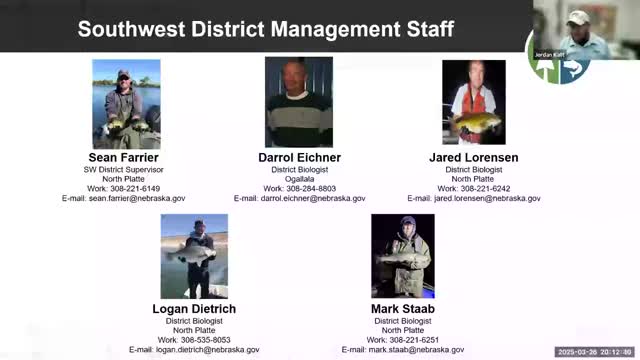Lake McConaughy sees rare walleye natural reproduction spike thanks to winter conditions
May 23, 2025 | Nebraska Game and Parks Commission (NGPC), State Agencies, Organizations, Executive, Nebraska
This article was created by AI summarizing key points discussed. AI makes mistakes, so for full details and context, please refer to the video of the full meeting. Please report any errors so we can fix them. Report an error »

Natural walleye reproduction at Lake McConaughy has seen a significant uptick, with the first documented increase since 2015 occurring in 2023. This development, discussed at the Nebraska Southwest District Fisheries Meeting, raises questions about the factors influencing walleye populations and the need for ongoing stocking efforts.
Experts noted that natural reproduction of walleye can be sporadic, with successful year classes appearing only once every eight years. The recent increase in 2023 is particularly intriguing, as it coincided with a winter kill event affecting the alewife population—an important food source for young fish. The harsh winter of 2022 may have reduced the alewife numbers, potentially improving the availability of zooplankton, which is crucial for the growth of juvenile walleye.
The discussion highlighted the delicate balance of fish populations in the reservoir, where high alewife abundance can negatively impact the quality of zooplankton. This bottleneck complicates natural reproduction, prompting fisheries managers to stock walleye to mitigate fluctuations in population.
In addition to walleye discussions, the meeting addressed the relocation of carp fishing events from Lake Oglala to Lake McConaughy. Participants sought insights on where to find concentrations of common carp, particularly in shallow waters and bays, as the event is scheduled for August. Experts suggested targeting areas like Otter Creek and Lemoyne, where carp are likely to congregate during their spawning runs.
The meeting underscored the importance of understanding fish dynamics in Nebraska's lakes, as fisheries managers continue to adapt strategies to support sustainable fish populations and recreational fishing opportunities.
Experts noted that natural reproduction of walleye can be sporadic, with successful year classes appearing only once every eight years. The recent increase in 2023 is particularly intriguing, as it coincided with a winter kill event affecting the alewife population—an important food source for young fish. The harsh winter of 2022 may have reduced the alewife numbers, potentially improving the availability of zooplankton, which is crucial for the growth of juvenile walleye.
The discussion highlighted the delicate balance of fish populations in the reservoir, where high alewife abundance can negatively impact the quality of zooplankton. This bottleneck complicates natural reproduction, prompting fisheries managers to stock walleye to mitigate fluctuations in population.
In addition to walleye discussions, the meeting addressed the relocation of carp fishing events from Lake Oglala to Lake McConaughy. Participants sought insights on where to find concentrations of common carp, particularly in shallow waters and bays, as the event is scheduled for August. Experts suggested targeting areas like Otter Creek and Lemoyne, where carp are likely to congregate during their spawning runs.
The meeting underscored the importance of understanding fish dynamics in Nebraska's lakes, as fisheries managers continue to adapt strategies to support sustainable fish populations and recreational fishing opportunities.
View full meeting
This article is based on a recent meeting—watch the full video and explore the complete transcript for deeper insights into the discussion.
View full meeting
